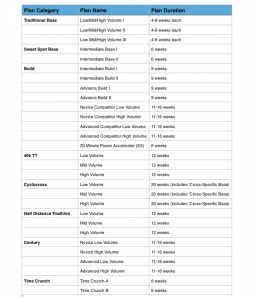Timing Your Training for Your Event
 With all of our available training plans and their associated plan durations, it can be a little challenging trying to decide which plan to use and when to start/end your best-fit plan relative to your key event(s). For instance, your Half-Ironman may not take place until September or you may be a roadie heading into some earlybird crits and road races in a month or two. And while we’ve already addressed the issue of plan selection in our Knowledge Base article aptly titled, “Selecting a Training Plan“, I’ve yet to offer some general advice on when to start your plan(s), when or if to modify their durations, and what to do with any interim time prior to or between the commencement of each training plan. So let’s start with an overview.
With all of our available training plans and their associated plan durations, it can be a little challenging trying to decide which plan to use and when to start/end your best-fit plan relative to your key event(s). For instance, your Half-Ironman may not take place until September or you may be a roadie heading into some earlybird crits and road races in a month or two. And while we’ve already addressed the issue of plan selection in our Knowledge Base article aptly titled, “Selecting a Training Plan“, I’ve yet to offer some general advice on when to start your plan(s), when or if to modify their durations, and what to do with any interim time prior to or between the commencement of each training plan. So let’s start with an overview.
The Overview
- Assign priority to your intended events.
- Count back from your top priority event(s).
- Select training plan(s) based on your goals & schedule.
- Modify plan durations, if necessary, based on your schedule.
- Fill free time with base training, cross-training or recovery.
Event Prioritization
First things first, you’ll need to assign priorities to your events, and while I prefer A/B/C rankings you’re welcome to use whatever is meaningful to you. I first choose my A-priority (top-priority) event, often referred to as my “key event”, and shape my entire season around that one event with a smattering of B- and C-priority events leading up to it.
Should you intend to accommodate 2 or even 3 A-priority events within a single season, consider developing 3 shorter training schedules all focused on their own single, A-priority event. This will allow you to develop each schedule separately in the manner described below. Then, you can address the periods between each of the shorter schedules in order to integrate these seemingly separate schedules into a single master schedule for the entire season.
Duration-Based Plan Selection

The overriding training goal is to bring your fitness to a peak for a brief period of time, right on time. This could mean a single weekend, it might be a multi-day event, it could even mean multiple events spread over a couple weeks or weekends. In any case, it’s a relatively short period of competition time in comparison to the potentially vast amount of training time leading up to it, but if you time things such that you end your final training plan the week prior to your event, you stand a good chance of performing well, maybe even to the full height of your capabilities.
Count back from your top priority event(s) to determine available training duration in weeks, then use the Plan Duration Table to determine which plans your schedule might accommodate. You’ll notice that some plans offer a range of durations, e.g. 4-6 weeks, but these ranges are explained in detail within each plan’s description on our Plans page. But even with these minor variations, you’ll be able to get an idea of what will fit your schedule and what isn’t reasonable should your event be on the near horizon.
Goal-Based Plan Selection
In conjunction with the number of available training weeks, you’ll also need base your plan selection on a number of other parameters, e.g. experience level, goal events, weekly training hours, etc., and this is where our Plan Selection Flowchart will help steer you in the right direction. You may also choose to perform this step first, but in either case these two steps will help you gain a better sense of your best-fit plan and when to begin it.
Modifying Plan Durations
It’s quite common to face a period of time prior to your key event(s) that doesn’t coincide with the length of your best-fit training plan, in which case you’ll have to decide whether to modify your chosen plan’s duration or choose another plan that might better fit your schedule.
If you decide to lengthen a plan, you can either veer toward the higher end of the duration range (if a range is offered), repeat the plan following another FTP assessment, or repeat a series of weeks based on perceived performance weaknesses or limiters making sure to properly dose your recovery days & weeks as well. For example, if you have 5 extra weeks and choose to repeat Sweet Spot Intermediate Base I, maybe you’ll first take a recovery week and then follow it by the first 4 weeks of this training plan.
Should you choose to trim your best-fit plan, be sensible when deciding which portion of the plan you’ll truncate. For example, if you’re coming into one of the CycloCross plans at the end of your road or multisport season, you may already have reasonably well-developed base conditioning and might choose to trim off the first 4 or even entire 8 weeks of ‘cross-specific base training in order to fold the plan into your proximate race season. Perhaps you’re a half-distance Ironman competitor and you only have 10 weeks to dedicate to base training and cutting the final 2 weeks off a Traditional Base plan makes sense considering the overlap you’ll then face when you begin one of the Half-Distance Triathlon plans. Get the idea?
Filling Non-Plan Training Time
Finally, you may be fortunate and hence gifted with ample time (or you’re simply that rare type of athlete who actually plans a season well ahead of time) and need to occupy periods of time that fall outside of your chosen training plans. In this case, you have a few options: base train, cross train, or rest.
You may choose to return to a period of lower-intensity mileage to not only take a break from the physiological & psychological rigors of higher-intensity conditioning but also to remind yourself that you can ride your bike for the sheer pleasure of riding – no structure, no goals, no time or mileage requirements – and simply ride because it’s fun.
Alternatively, you may wish to do something entirely different for a period of time and completely get away from the bike or simply cut your saddle time with some varied but complementary activities like running, hiking, paddleboarding, or kayaking. This may also be a period of time you choose to dedicate to resistance training of some kind.
Finally, maybe it’s time to rest. Maybe you have a single limbo-week and you just finished burying yourself so deeply with your training that a single recovery week on the bike hasn’t left you fresh or motivated enough to dive into your next phase of training. Be smart, use these gaps intelligently and base them on what you know about yourself both as an athlete and a person and change things up enough that you don’t get so mired down with TSS points and FTP percentages that you lose sight of how fun all of this is supposed to be!
Train smart, ride hard, have fun.
